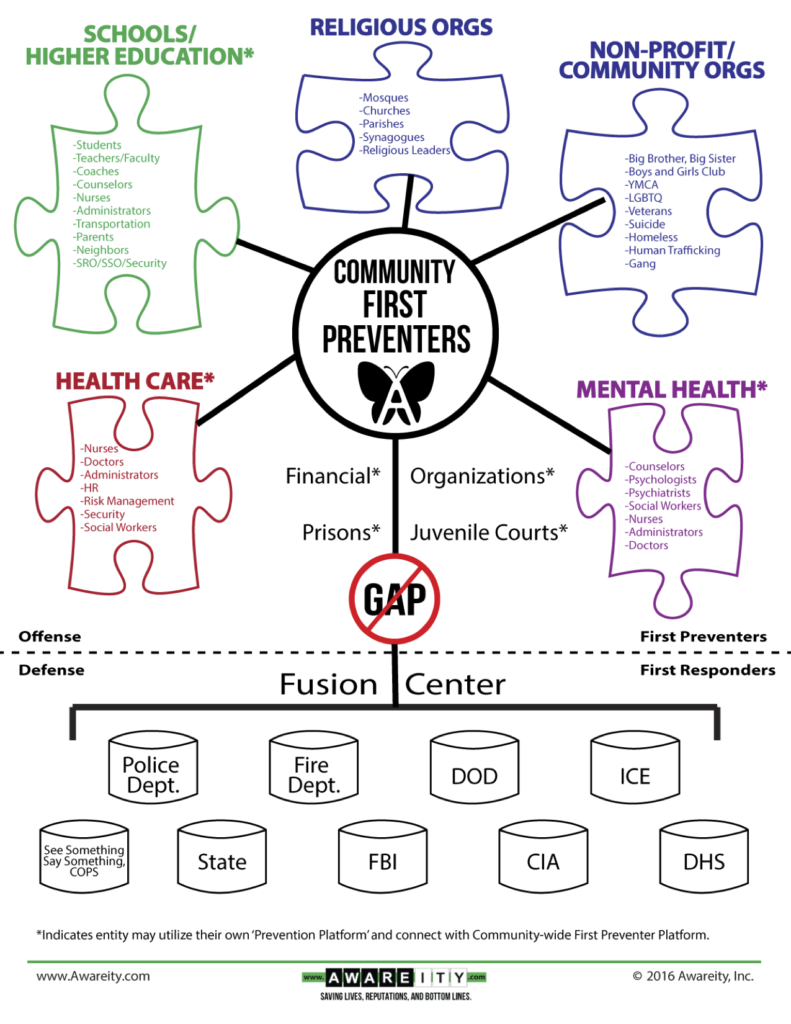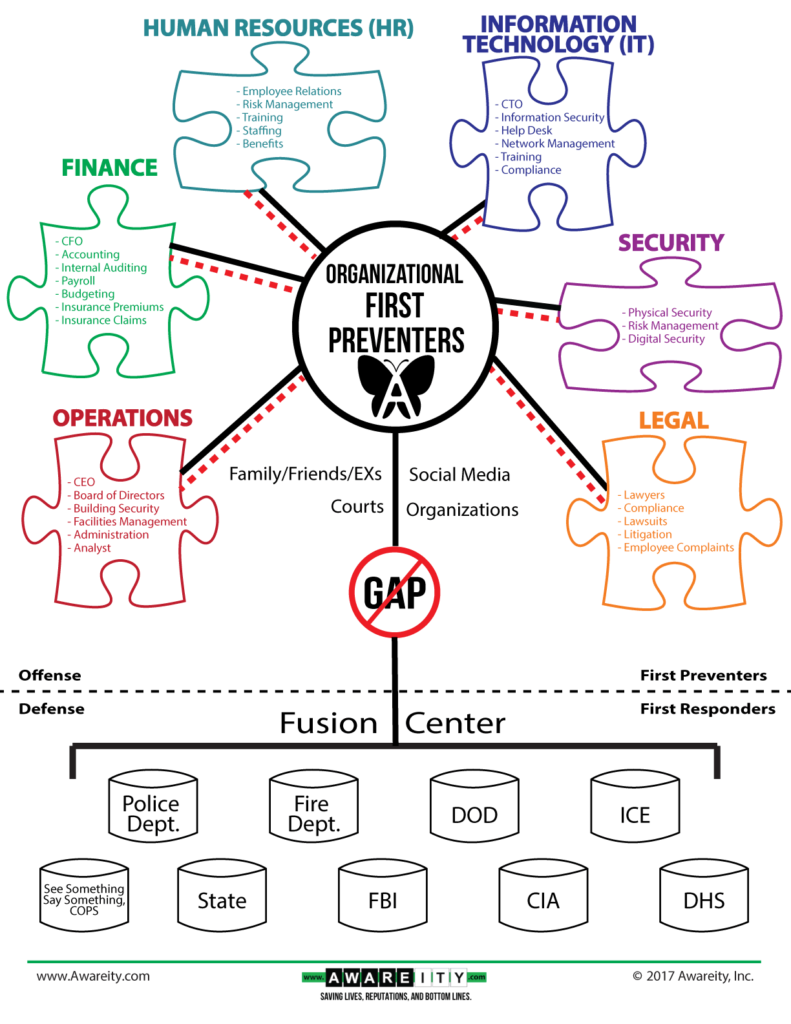
Dangerous GAPS
Evidence from hundreds of post-incident reports reveal almost every organization and community has a myriad of common GAPS and dangerous GAPS.
At-Risk Individuals
Evidence reveals almost every organization and/or community has at-risk individuals who could commit numerous types of disruptive incidents involving people, information, organizations, and communities.
Disruptive Incidents
Evidence reveals alarming trends involving numerous types of disruptive incidents including terrorism, homicides, workplace violence, gang violence, drugs, crimes, sexual assaults, human trafficking, suicides, and numerous others.
Dangerous GAPS and Disruptive Incidents
Unless (and until) dangerous GAPS are eliminated, disruptive incidents, tragedies, and numerous other unwanted, embarrassing, and costly consequences will be difficult if not impossible to prevent.
Research and hundreds of headlines, post-incident reports, and lessons learned reveal community members almost always observed at-risk individuals and pre-incident indicators BEFORE disruptive incidents occurred, but due to a myriad of dangerous GAPS, the right people in organizations and/or communities were not aware of the observed pre-incident indicators and/or previous incidents, concerning behaviors, suspicious activities, and other critical pieces of the puzzle and therefore could NOT see the bigger picture to successfully intervene and prevent at-risk individuals from escalating and executing disruptive plans or acts of evil.
Common and Dangerous Community-related GAPS include…
 GAPS between First Responders and First Preventers (if First Preventers even officially exist?)
GAPS between First Responders and First Preventers (if First Preventers even officially exist?)
Most communities and organizations have made significant investments in First Responders (people), First Responder equipment, First Responder Training, First Responder Emergency Plans, First Responder Crisis Response Plans, etc. First Responder investments are clearly needed. However, when the focus and investments are almost entirely on First Responders, communities, and organizations will find themselves in “Responder Mode” most of the time because of First Preventer GAPS where First Preventers are not defined, not organized, not equipped, not trained, not connected community-wide, not connected to securely share information in real time with community-wide teams/resources, etc. First Preventers are needed because First Responders have limitations on what they can or cannot do if a crime has not yet been committed, whereas First Preventers could be intervening and preventing if they existed and if they were equipped with the right tools to do the right things.
GAPS involving First Preventers and Community-based Threat Assessment Teams (CTATs)
Most communities do not have an official Community-based Threat Assessment Team (CTAT) that is trained, equipped, and “securely connected online” to share “pieces of the puzzle” so they can see the bigger picture and do the right things at the right times to intervene and prevent. Because most communities do not have a CTAT, the community must deal with a myriad of common and dangerous GAPS between what Community Resources know, what Community Organizations know, what Community Members know, what Internet Community Members know as well as numerous silos (individuals, departments, locations, systems, etc.) scattered around the community. Even if a CTAT does exist, if the CTAT cannot access, assess, and connect all of the “pieces of the puzzle” that exist involving at-risk situations and at-risk individuals… they will struggle to intervene and prevent because they cannot intervene and prevent what they do not know about.
- GAPS between Local Community Members know and what First Preventers/Law Enforcement knows.
- GAPS between what Internet Community Members know and what First Preventers/Law Enforcement knows.
- GAPS between what Students know and what First Preventers/Law Enforcement knows.
- GAPS between what Schools know and what First Preventers/Law Enforcement knows.
- GAPS between what Colleges know and what First Preventers/Law Enforcement knows.
- GAPS between what Health Care organizations know and what First Preventers/Law Enforcement knows.
- GAPS between what Mental Health organizations know and what First Preventers/Law Enforcement knows.
- GAPS between what Religious organizations know and what First Preventers/Law Enforcement knows.
- GAPS between what Non-Profit Community organizations know and what First Preventers/Law Enforcement knows.
- GAPS between what Financial organizations know and what First Preventers/Law Enforcement knows.
- GAPS between what Other Community organizations know and what First Preventers/Law Enforcement knows.
- GAPS between what Juvenile Courts know and what First Preventers/Law Enforcement knows.
- GAPS between what Prisons know and what First Preventers/Law Enforcement knows.
- GAPS between what Federal Government knows and what First Preventers/Law Enforcement knows.
- GAPS between what State Government knows and what First Preventers/Law Enforcement knows.
Common and Dangerous Organization related GAPS include…
 GAPS between First Preventers and Multi-Disciplinary Threat Assessment Teams (MTATs), if either officially exist within an organization.
GAPS between First Preventers and Multi-Disciplinary Threat Assessment Teams (MTATs), if either officially exist within an organization.
As previously mentioned, most organizations have made significant investments in First Responders (people), First Responder equipment, First Responder Training, First Responder Emergency Plans, First Responder Crisis Response Plans, etc. First Responder investments are clearly needed. However, when the focus and investments are almost entirely on First Responders, communities and organizations will find themselves in “Responder Mode” most of the time. Most organizations do not have an MTAT that is trained, equipped, and “securely connected online” to access, assess, share, and connect “pieces of the puzzle” so they can see the bigger picture and do the right things at the right times to intervene and prevent. Because most organizations do not have an MTAT, one of more people face a myriad of common and dangerous GAPS between what Employees know, what Community Members (family, friends, neighbors, ex-significant others, etc.) know, what Internet Community Members know as well as what Community Resources know. Without a trained and equipped MTAT, organizations will struggle to intervene and prevent disruptive incidents and challenges because they cannot intervene and prevent what they do not know about.
- GAPS between what Employees know and what First Preventers/MTAT knows.
- GAPS between what Friends and Family of Employees know and what First Preventers/MTAT knows.
- GAPS between what Human Resources knows and what First Preventers/MTAT knows.
- GAPS between what Security Personnel know and what First Preventers/MTAT know.
- GAPS between what Legal knows and what First Preventers/MTAT knows.
- GAPS between what EAP knows and what First Preventers/MTAT knows.
- GAPS between what IT knows and what First Preventers/MTAT knows.
- GAPS between what Safety Personnel know and what First Preventers/MTAT knows.
- GAPS between what Clients/Patients know and what First Preventers/MTAT knows.
- GAPS between what Courts (restraining orders, etc.) know and what First Preventers/MTAT knows.
- GAPS between what Local Community Members know and what First Preventers/MTAT knows.
- GAPS between what Schools/Students know and what First Preventers/MTAT knows.
- GAPS between what Internet Community Members know and what First Preventers/MTAT knows.
- GAPS between what Law Enforcement knows and what First Preventers/MTAT knows.
- GAPS between what Hospitals know and what First Preventers/MTAT knows.
- GAPS between what Mental Health organizations know and what First Preventers/MTAT knows.
- GAPS between what Religious organizations know and what First Preventers/MTAT knows.
- GAPS between what Non-Profit Community organizations know and what First Preventers/MTAT knows.
Common and Dangerous System related GAPS include…
GAPS between what Departmental systems have documented and what First Preventers/MTAT knows.
Evidence-based data from hundreds of post-incident reports repeatedly expose how “pieces of the puzzle” (pre-incident indicators, concerning behaviors, suspicious activities, threats, related and escalating incidents, social media leakage, etc.) were almost always observed and documented, but most “pieces of the puzzle” were scattered across numerous silo-systems including HR, Security, Legal, Conduct, IT, Risk, Compliance, Case Management, EAP, Safety, Attendance, and other internal systems/databases, etc. Evidence-based data also reveals how “pieces of the puzzle” were scattered across multiple external systems across the community.
Common and Dangerous Communications related GAPS include…
GAPS in communications due to conventional “best practices” and manually intensive “best practices” also prevent the right information from getting to the right people in the right places at the right time so they can do the right things and take the right actions.
GAPS created by using e-mail for communications between MTAT / CTAT members which can subject sensitive information, legal evidence, investigation data, and vital “pieces of the puzzle” to disclosure laws (FOIA, Open Records, etc.) and to being accidentally sent or forwarded to unauthorized people.
GAPS created by using meetings (weekly, bi-weekly, monthly, etc.) for communications between MTAT / CTAT members which can keep vital and timely “pieces of the puzzle” from being acted on BEFORE an escalation or incident occurs.
GAPS created by using spreadsheets and paper documents that make it difficult to share updates with MTAT / CTAT members.
GAPS created by failing to ensure regulatory awareness of HIPAA, FERPA, and other privacy laws that keep vital “pieces of the puzzle” from being shared with MTAT /CTAT members.
According to evidence-based data, lawsuits, and other lessons learned, until these and other GAPS are eliminated, organizations and communities will struggle to prevent preventable incidents and tragedies.
Want to find your gaps before they expose you? Request information on a Gap Assessment today!
